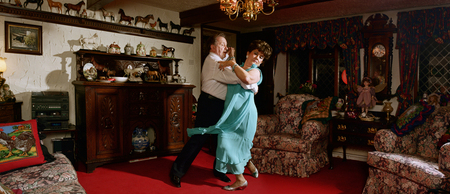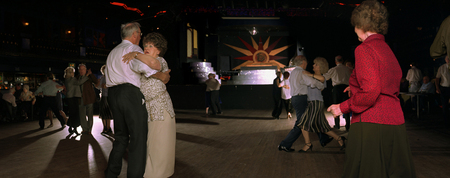Elaine Constantine Tea Dance





Elaine Constantine. Trafford Centre. 2002. © Elaine Constantine/Marco Santucci Photography
Elaine Constantine. Liz and Norman. 2002. © Elaine Constantine/Marco Santucci Photography
Elaine Constantine. The Ritz Ballroom. 2002. © Elaine Constantine/Marco Santucci Photography
Elaine Constantine. Tango at the Ritz. 2002. © Elaine Constantine/Marco Santucci Photography
Elaine Constantine. Alex and Ivey. 2002. © Elaine Constantine/Marco Santucci Photography
Moscow, 18.03.2005—10.04.2005
exhibition is over
Moscow Museum of Modern Art
17 Ermolaevsky lane (
www.mmoma.ru
Share with friends
Project originally commissioned by Castlefield Gallery, Manchester, England
Project presented by The Marco Santucci Photography, England
For the press
For documentary photographers, the spectacle of the dance offers a myriad of opportunities. As courtship ritual, as celebration, as physical embrace, as a mysterious and fraught moment between strangers, it presents photographers with a tantalising mixture of sexuality, grace and vulnerability- fantastic and intimate scenarios presented in a public place. Visually compelling as it is, the ballroom, whether formal or in some improvised public space, has also been used by photographers to make important points about the world in which we live.
Interestingly, in the 1990s, and with the rise of the anti-establishment Britart, many young British artists chose to again use the symbol of the dance to describe society, or rather to examine their place within society, and audiences became familiar with the spectacle of young women artists dancing alone as Tracy Emin reanacted her childhood dreams and disappointments and Gillian Wearing danced alone in a brutalised shopping centre in South London.
Brought to public attention by the media furore created around Corinne Day’s 1993 Vogue shoot of emerging waif model Kate Moss, alone in a shabby bedsit, discussion around fashion during the 1990s revolved around the (disputed) genre of heroin chic, in which models stared vacantly at the world around them, often against the background of the transgressive territories of the inner city. This photography of disaffection propelled fashion photography to centre stage, and much of the iconography of German/Swiss art photography of the late Eighties became accepted fashion staples (epitomised by the work of Wolfgang Tillmans, and, to a lesser extent, Juergen Teller). In this new photography, young men and women were alone, disaffected, almost inert. No one was dancing, except those who danced alone. Elaine Constantine’s 1990s fashion photography exploded into this vacuum, challenging a visual idiom which, until then, had seemed to be unchallengable. Unlike most of her contemporaries, Elaine Constantine was immersed in a documentary tradition which had always been fascinated by the vernacular. She was impressed by the work of English colour documentarist Martin Parr, by Terence Spencer’s 60s photographs of Mods and by Nick Knight’s stylised photodocumentary of Skinheads. Although Elaine Constantine has become well known for her aspirational photo shoots of energised young women, her major impetus in photography and the interests which informed the earlier photo stories which made her name on the London style scene was the energy of vernacular dance culture: "I have been attending northern soul all-nighters since I was sixteen, and this has had a profound effect on my photography... I didn’t succeed academically at school and the only thing I could do well was dance. I think that in photography, I am trying to articulate my own experience on the dance floor’. In Mosh, Elaine Constantine’s groundbreaking 1997 fashion spread for The Face magazine, in which a crowd of young people were photographed crowd surfing, drinking, dancing, a new kind of fashion photography emerged onto a style scene which had become melancholic and somewhat stultified. Full of energy (and even violence) Mosh symbolised a break with the past and with the voguish Germanic photography, which had dominated the fashion scene, and reinvented the notion of English photodocumentary at the heart of the style press.
In 2002, Elaine Constantine moved away from the photography of youth fashion, to make a remarkable series of photographs about tea dances in the north west of England. This was a very personal project (two of the dancers are Constantine’s parents, and many of the others are friends) a salutation to the vitality of age as well as to tradition. In Tea Dance, she has travelled far beyond documentary style to make a series of large-scale photographs in which the dancers are stilled in motion, figures in severe tableaux in which the participants are engaged in some ancient and melancholic ritual. By stilling the dancers so rigorously, Constantine has made an important statement on the status of photography as a maker of moments, a stopper of time and a recorder of memory. Though her purpose, in emphasising in the vitality and physicality of old age, was the undoubted impetus for these photographs, at their centre, there is an overwhelming sense of imminent loss. Emerging from the dark shadows, performing the perfect dance movement, hands locked and clothes swirling, the people in these photographs emerge onto the stage of the ballroom or the practice area almost as statues or as ghosts, performers in a melancholy comedy of manners. In many ways, Tea Dance is a distillation of the state of photography in these first years of the 21st century, epitomising as it photography’s ongoing and perpetual debate around the staging of the real. Elaine Constantine’s new work perhaps joins that of an already well established group of photographers, including Hannah Starkey, Roger Ballen, Tom Hunter and others, who have experimented along the borders of the documentary image, intriguing audiences and challenging the way we look at photographs. Like Hannah Starkey in her Untitled tableaux of the late 1990s, in which models re-enacted moments from every day life remembered by Starkey as she moved around the city, Elaine Constantine has made a series of great dramatic endeavours, whose subjects inhabit our real world, but whose presence in the photographs are a testimony to photography’s power to go beyond the real and make statements which reflect on the solemn importance of the grandly everyday.
There is, in these photographs, an acknowledgement of photography’s consummate ability to memorialise, to bear witness, to be in the presence of ghosts. Constantine has avoided the usual impulse of photographers who portray old age to make their subjects into victims or heroes and has become complicit with them in the performance of a complex and serious ritual, a dance of memory and a degree of acceptance. Like some grave chorus of elders, Elaine Constantine’s dancers are present not to defy time, but to memorialise it.
Val Williams


